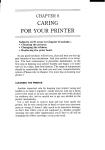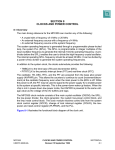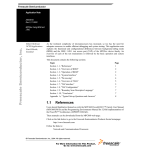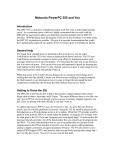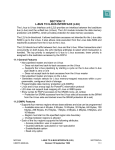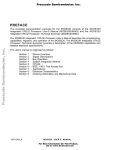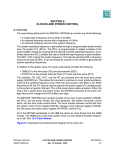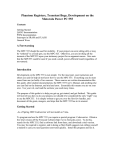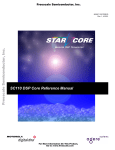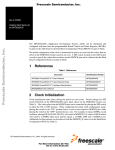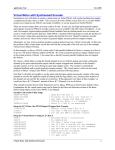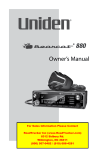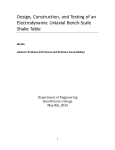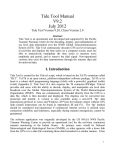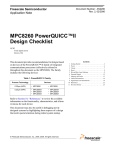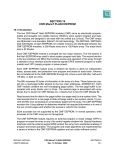Download 7.5.2 Hard Reset Configuration Word
Transcript
SECTION 7 RESET This section describes the MPC555 reset sources, operation, control, and status. 7.1 Reset Operation The MPC555 has several inputs to the reset logic which include the following: • Power on reset • External hard reset pin (HRESET) • External soft reset pin (SRESET) • Loss of lock • On-chip clock switch • Software watchdog reset • Checkstop reset • Debug port hard reset • Debug port soft reset • JTAG reset All of these reset sources are fed into the reset controller. The control logic determines the cause of the reset, synchronizes it if necessary, and resets the appropriate logic modules, depending on the source of the reset. The memory controller, system protection logic, interrupt controller, and parallel I/O pins are initialized only on hard reset. External soft reset initializes internal logic while maintaining system configuration. The reset status register (RSR) reflects the most recent source to cause a reset. 7.1.1 Power On Reset The power-on reset pin, PORESET, is an active low input. In a system with powerdown low-power mode, this pin should be activated only as a result of a voltage failure in the KAPWR pin. After detecting the assertion of PORESET, the MPC555 enters the power-on reset state. During this state the MODCK[1:3] signals determine the oscillator frequency, PLL multiplication factor, and the PITRCLK and TMBCLK clock sources. In addition, the MPC555 asserts the SRESET and HRESET pins. The PORESET pin should be asserted for a minimum time of 100,000 cycles of clock oscillator after a valid level has been reached on the KAPWR supply. After detecting the assertion of PORESET, the MPC555 remains in the power-on reset state until the last of the following two events occurs: • The Internal PLL enters the lock state and the system clock is active. • The PORESET pin is negated. If the MPC555 is in single-chip mode and limp mode is enabled, the internal PLL is not required to be locked before the chip exits power-on reset. MPC555 USER’S MANUAL RESET Revised 15 September 1999 MOTOROLA 7-1 After exiting the power-on reset state, the MCU continues to drive the HRESET and SRESET pins for 512 system clock cycles. When the timer expires (after 512 cycles), the configuration is sampled from data bus pins, if required (see 7.5.1 Hard Reset Configuration) and the MCU stops driving the HRESET and SRESET pins. In addition, the internal MODCK[1:3] values are sampled. The PORESET pin has a glitch detector to ensure that low spikes of less than 20 ns are rejected. The internal PORESET signal asserts only if the PORESET pin asserts for more than 100 ns. 7.1.2 Hard Reset HRESET (hard reset) is an active low, bi-directional I/O pin. The MPC555 can detect an external assertion of HRESET only if it occurs while the MCU is not asserting reset. When the MPC555 detects assertion of the external HRESET pin or a cause to assert the internal HRESET line, is detected the chip starts to drive the HRESET and SRESET for 512 cycles. When the timer expires (after 512 cycles) the configuration is sampled from data pins (refer to 7.5.1 Hard Reset Configuration) and the chip stops driving the HRESET and SRESET pins. An external pull-up resistor should drive the HRESET and SRESET pins high. After detecting the negation of HRESET or SRESET, the MCU waits 16 clock cycles before testing the presence of an external hard or soft reset. The HRESET pin has a glitch detector to ensure that low spikes of less than 20 ns are rejected. The internal HRESET will be asserted only if HRESET is asserted for more than 100 ns. The HRESET is an open collector type pin. 7.1.3 Soft Reset SRESET (soft reset) is an active low, bi-directional I/O pin. The MPC555 can only detect an external assertion of SRESET if it occurs while the MPC555 is not asserting reset. When the MPC555 detects the assertion of external SRESET or a cause to assert the internal SRESET line, the chip starts to drive the SRESET for 512 cycles. When the timer expires (after 512 cycles) the debug port configuration is sampled from the DSDI and DSCK pins and the chip stops driving the SRESET pin. An external pull-up resistor should drive the SRESET pin high. After the MPC555 detects the negation of SRESET, it waits 16 clock cycles before testing the presence of an external soft reset. 7.1.4 Loss of Lock If the PLL detects a loss of lock, erroneous external bus operation will occur if synchronous external devices use the MPC555 input clock. Erroneous operation could also occur if devices with a PLL use the MPC555 CLKOUT signal. This source of reset can be optionally asserted if the LOLRE bit in the PLL, low-power, and reset control register (PLPRCR) is set. The enabled PLL loss of lock event generates an internal MPC555 USER’S MANUAL RESET Revised 15 September 1999 MOTOROLA 7-2 hard reset sequence. Refer to SECTION 8 CLOCKS AND POWER CONTROL for more information on loss of lock. 7.1.5 On-Chip Clock Switch If the system clocked is switched to the backup clock or switched from backup clock to another clock source an internal hard reset sequence is generated. Refer to SECTION 8 CLOCKS AND POWER CONTROL. 7.1.6 Software Watchdog Reset When the MPC555 software watchdog counts to zero, a software watchdog reset is asserted. The enabled software watchdog event generates an internal hard reset sequence. 7.1.7 Checkstop Reset When the RCPU enters a checkstop state, and the checkstop reset is enabled (the CSR bit in the PLPRCR is set), a checkstop reset is asserted. The enabled checkstop event generates an internal hard reset sequence. Refer to the RCPU Reference Manual (RCPURM/AD) for more information. 7.1.8 Debug Port Hard Reset When the development port receives a hard reset request from the development tool, an internal hard reset sequence is generated, see SECTION 8 CLOCKS AND POWER CONTROL. In this case the development tool must reconfigure the debug port. Refer to SECTION 21 DEVELOPMENT SUPPORT for more information. 7.1.9 Debug Port Soft Reset When the development port receives a soft reset request from the development tool, an internal soft reset sequence is generated, see SECTION 8 CLOCKS AND POWER CONTROL. In this case the development tool must reconfigure the debug port. Refer to SECTION 21 DEVELOPMENT SUPPORT for more information. 7.1.10 JTAG Reset When the JTAG logic asserts the JTAG soft reset signal, an internal soft reset sequence is generated, see SECTION 8 CLOCKS AND POWER CONTROL. Refer to SECTION 22 IEEE 1149.1-COMPLIANT INTERFACE (JTAG) for more information. 7.2 Reset Actions Summary Table 7-1 summarizes the action taken for each reset. MPC555 USER’S MANUAL RESET Revised 15 September 1999 MOTOROLA 7-3 Table 7-1 Reset Action Taken For Each Reset Cause Reset Source Power On Reset Hard Reset Sources External Hard Reset Loss of Lock On-Chip Clock Switch Illegal Low-Power Mode Software Watchdog Checkstop Debug Port Hard Reset Soft Reset Sources External Soft Reset Debug Port Soft Reset JTAG Reset Reset System Logic and ConfiguraPLL States tion Reset Reset Yes Yes Clock Module Reset Yes Debug HRESET Port Pin Driven Configuration Yes Yes Other Internal Logic Reset Yes SRESET Pin Driven Yes No Yes Yes Yes Yes Yes Yes No No No No Yes Yes Yes 7.3 Data Coherency During Reset The MPC555 supports data coherency and avoids data corruption while reset. If a cycle is to be executed when detecting any SRESET or HRESET source, then the cycle will either complete or will not start before generating the corresponding reset control signal. There are reset sources, however, when the MPC555 generates an internal reset due to special internal situation where this protection is not supported. See 7.4 Reset Status Register. In the case of large operand size (32 or 16 bits) transaction to a smaller port size, the cycle is split into two 16-bit or four 8-bit cycles. In this case, data coherency is assured and data will not be corrupted. In the case where the core executes an unaligned load/store cycle which is broken down into multiple cycles, data coherency is NOT assured between these cycles (i.e. data could be corrupted). A contention on the data pins may occur while asserting external reset (EXT_RESET) if the data coherency mechanism is required, and thus enables a cycle to complete, while external hardware drives the data for the configuration word. See Table 7-2 for a description of the required EXT_RESET line source in a system. Table 7-2 Reset Configuration Word and Data Corruption/Coherency Reset Driven Reset to Use for Data Coherency (EXT_RESET) HRESET SRESET SRESET HRESET HRESET & SRESET HRESET || SRESET MPC555 USER’S MANUAL RESET Revised 15 September 1999 Comments Provided only one of them is driven into the MPC555 at a time MOTOROLA 7-4 7.4 Reset Status Register All of the reset sources are fed into the reset controller. The 16-bit reset status register (RSR) reflects the most recent source, or sources, of reset. (Simultaneous reset requests can cause more than one bit to be set at the same time.) This register contains one bit for each reset source. A bit set to logic one indicates the type of reset that occurred. Once set, individual bits in the RSR remain set until software clears them. Can be cleared by writing a one to the bit. A write of zero has no effect on the bit. The register can be read at all times. The reset status register receives its default reset values during power-on reset. The RSR is powered by the KAPWR pin. RSR — Reset Status Register 0x2F C288 MSB 0 1 2 3 4 EHRS ESRS LLRS SWRS CSRS 0 0 0 0 5 6 DBHRS DBSRS 7 8 9 JTRS OCCS ILBC 0 0 0 10 11 12 13 GPOR GHRST GSRST 14 15 RESERVED RESET: 0 0 0 1 1 1 0 0 0 Table 7-3 Reset Status Register Bit Settings Bit(s) Name Description 0 EHRS1 External hard reset status 0 = No external hard reset has occurred 1 = An external hard reset has occurred 1 ESRS1 External soft reset status 0 = No external soft reset has occurred 1 = An external soft reset has occurred 2 LLRS Loss of lock reset status 0 = No enabled loss-of-lock reset has occurred 1 = An enabled loss-of-lock reset has occurred 3 SWRS Software watchdog reset status 0 = No software watchdog reset has occurred 1 = A software watchdog reset has occurred 4 CSRS Checkstop reset status 0 = No enabled checkstop reset has occurred 1 = An enabled checkstop reset has occurred 5 DBHRS Debug port hard reset status 0 = No debug port hard reset request has occurred 1 = A debug port hard reset request has occurred 6 DBSRS Debug port soft reset status 0 = No debug port soft reset request has occurred 1 = A debug port soft reset request has occurred 7 JTRS JTAG reset status 0 = No JTAG reset has occurred 1 = A JTAG reset has occurred MPC555 USER’S MANUAL RESET Revised 15 September 1999 MOTOROLA 7-5 Table 7-3 Reset Status Register Bit Settings (Continued) Bit(s) 8 9 10 11 12 13:15 Name Description OCCS On-chip clock switch 0 = No on-chip clock switch reset has occurred 1 = An on-chip clock switch reset has occurred ILBC Illegal bit change. This bit is set when the MPC555 changes any of the following bits when they are locked: LPM[0:1], locked by the LPML bit MF[0:11], locked by the MFPDL bit DIVF[0:4], locked by the MFPDL bit GPOR Glitch detected on PORESET pin. This bit is set when the PORESET pin is asserted for more than TBD ns 0 = No glitch was detected on the PORESET pin 1 = A glitch was detected on the PORESET pin GHRST Glitch detected on HRESET pin. This bit is set when the HRESET pin is asserted for more than TBD ns 0 = No glitch was detected on the HRESET pin 1 = A glitch was detected on the HRESET pin GSRST Glitch detected on SRESET pin. If the SRESET pin is asserted for more than TBD ns the GHRST bit will be set. If an internal or external SRESET is generated the SRESET pin is asserted and the GSRST bit will be set. The GSRST bit remains set until software clears it. The GSRST bit can be negated by writing a one to GSRST. A write of zero has no effect on this bit. 0 = No glitch was detected on SRESET pin 1 = A glitch was detected on SRESET pin. — Reserved NOTES: 1. In the USIU RSR, if both EHRS and ESRS are set, the reset source is internal. The EHRS and ESRS bits in RSR register are set for any internal reset source in addition to external HRESET and external SRESET events. If both internal and external indicator bits are set, then the reset source is internal. 7.5 Reset Configuration 7.5.1 Hard Reset Configuration When a hard reset event occurs, the MPC555 reconfigures its hardware system as well as the development port configuration The logical value of the bits that determine its initial mode of operation, are sampled from the following: • The external data bus pins DATA[0:31] • An internal default constant (0x0000 0000) • An internal NVM register value (CMFCFIG) If at the sampling time RSTCONF is asserted, then the configuration is sampled from the data bus. If RSTCONF is negated and a valid NVM value exists (CMFCFIG bit HC=0), then the configuration is sampled from the NVM register in the CMF module. If RSTCONF is negated and no valid NVM value exists (CMFCFIG bit HC=1), then the configuration word is sampled from the internal default. HC will be “1” if the internal flash is erased. Table 7-4 summarizes the reset configuration options. MPC555 USER’S MANUAL RESET Revised 15 September 1999 MOTOROLA 7-6 Table 7-4 Reset Configuration Options RSTCONF Has Configuration (HC) Internal Configuration Word 0 x DATA[0:31] pins 1 0 NVM flash EEPROM register (CMFCFIG) 1 1 Internal data word default (0x0000 0000) If the PRDS control bit in the PDMCR register is set and HRESET and RSTCONF are asserted, the MPC555 pulls the data bus low with a weak resistor. The user can overwrite this default by driving the appropriate bit high. See Figure 7-1 for the basic reset configuration scheme. Has Configuration HC Config. Word 32 MUX CMF 32 32 OE Dx (Data line) INT_RESET Data Coherency EXT_RESET (See Table 7.2) HRESET/SRESET RSTCONF MPC555 Figure 7-1 Reset Configuration Basic Scheme During the assertion of the PORESET input signal, the chip assumes the default reset configuration. This assumed configuration changes if the input signal RSTCONF is asserted when the PORESET is negated or the CLKOUT starts to oscillate. To ensure MPC555 USER’S MANUAL RESET Revised 15 September 1999 MOTOROLA 7-7 that stable data is sampled, the hardware configuration is sampled every eight clock cycles on the rising edge of CLKOUT with a double buffer. The setup time required for the data bus is approximately 15 cycles, and the maximum rise time of HRESET should be less than 6 clock cycles. In systems where an external reset configuration word and the TEXP output function are both required, RSTCONF should be asserted until SRESET is negated. Figure 7-2 to Figure 7-5 provide sample reset configuration timings. CLKOUT PORESET Internal PORESET HRESET RSTCONF Tsup Internal DATA[0:31] Default RSTCONF Controlled Figure 7-2 Reset Configuration Sampling Scheme For “Short” PORESET Assertion, Limp Mode Disabled MPC555 USER’S MANUAL RESET Revised 15 September 1999 MOTOROLA 7-8 CLKOUT (Backup Clock) PORESET Internal PORESET HRESET RSTCONF Tsup Internal DATA(0:31) Default RSTCONF Controlled Figure 7-3 Reset Configuration Timing for “Short” PORESET Assertion, Limp Mode Enabled CLKOUT PLL lock PORESET Internal PORESET HRESET RSTCONF Tsup Internal DATA[0:31] Default RSTCONF Controlled Figure 7-4 Reset Configuration Timing for “Long” PORESET Assertion, Limp Mode Disabled MPC555 USER’S MANUAL RESET Revised 15 September 1999 MOTOROLA 7-9 Figure 7-5 Reset Configuration Sampling Timing Requirements MPC555 USER’S MANUAL Revised 15 September 1999 RESET MOTOROLA 7-10 3 4 5 6 7 8 10 11 12 13 14 15 Maximum time of reset recognition (maximum rise time - up to 6 clocks) 9 Sample Data Configuration Tsup = Minimum Setup time of reset recognition = 15 clocks RESET CONFIGURATION WORD 2 Sample Data Configuration Internal reset Data RSTCONF HRESET CLKOUT 1 16 7.5.2 Hard Reset Configuration Word The hard reset configuration word, which is sampled from the internal data bus on the negation of HRESET, is shown below. The reset configuration word is not a register in the memory map. Most of the bits in the configuration are located in registers in the USIU. The user should refer to the appropriate register definition for a detailed description of each control bit. Hard Reset Configuration Word MSB 0 1 2 3 EARB IP BDRV BDIS 0 0 4 5 6 BPS 7 8 9 Reserved 10 DBGC 11 12 13 DBPC ATWC 14 15 Reserved EBDF DEFAULT: 0 0 0 0 0 0 0 0 0 0 0 0 0 0 LSB 16 17 PRPM 18 SC 19 20 ETRE FLEN 0 0 21 22 Reserved 23 24 CLES 25 26 27 28 Reserved 29 30 ISB 31 DME DEFAULT: 0 0 0 0 0 0 0 0 0 0 0 0 0 0 Table 7-5 Hard Reset Configuration Word Bit Settings Bit(s) 0 Name EARB Description External arbitration. Refer to 6.13.1.1 SIU Module Configuration Register for a detailed bit definition. 0 = Internal arbitration is performed 1 = External arbitration is assumed IP Initial interrupt prefix. This bit defines the initial value of the MSR[IP] bit immediately after reset. MSR[IP] defines the interrupt table location. 0 = MSR[IP] = 0 after reset 1 = MSR[IP] = 1 after reset 2 BDRV Bus pins drive strength. This bit determines the driving capability of the bus pins (address, data, and control) and the CLKOUT pin. For details, refer to description of the COM bits in 8.12.1 System Clock Control Register (SCCR). The default value is full drive strength for the bus pins and CLKOUT. 0 = Full drive 1 = Reduced drive 3 BDIS External boot disable. If a write to the OR0 register occurs after reset, this bit definition is ignored. 0 = Memory controller bank 0 is active and matches all addresses immediately after reset 1 = Memory controller is not activated after reset. 4:5 BPS Boot port size. If a write to the OR0 register occurs after reset, this field definition is ignored. 00 = 32-bit port (default) 01 = 8-bit port 10 = 16-bit port 11 = Reserved 6:8 — 9:10 DBGC 1 MPC555 USER’S MANUAL Reserved Debug pins configuration. See 6.13.1.1 SIU Module Configuration Register for this field definition. The default value is for these pins to function as VFLS[0:1], BI, BR, BG, and BB. RESET Revised 15 September 1999 MOTOROLA 7-11 Table 7-5 Hard Reset Configuration Word Bit Settings (Continued) Bit(s) Name Description 11 DGPC Debug port pins configuration. See 6.13.1.1 SIU Module Configuration Register for this field definition. The default value is for these pins to function as development support pins. 12 ATWC Address type write-enable configuration. Refer to 6.13.1.1 SIU Module Configuration Register for this field definition. The default value is for these pins to function as write-enable pins. 13:14 EBDF External bus division factor. This field defines the initial value of the external bus frequency. Refer to 8.12.1 System Clock Control Register (SCCR) for details. The default value is that CLKOUT frequency is equal to that of the internal clock (divide by one). 15 — 16 PRPM Reserved Peripheral mode enable. This bit determines whether the chip is in peripheral mode. Refer to 6.13.1.3 External Master Control Register (EMCR) for details. The default value is that peripheral mode is not enabled. Single chip select. Refer to 6.13.1.1 SIU Module Configuration Register for details. 00 = Extended chip, 32 bits data 01 = Extended chip, 16 bits data 10 = Single chip and show cycles (address) 11 = Single chip 17:18 SC 19 ETRE Exception table relocation enable. This field defines whether the exception table relocation feature in the BBC is enabled or disabled. The default state is disabled. Refer to SECTION 4 BURST BUFFER for details. 20 FLEN Flash enable. Refer to 6.13.1.2 Internal Memory Map Register for details. 0 = Flash disabled — boot is from external memory 1 = Flash enabled 21:22 — 23 CLES 24:27 — 28:30 ISB Initial internal space base select. This field defines the initial value of the ISB field in the IMMR register. Refer to 6.13.1.2 Internal Memory Map Register for details. The default state is that the internal memory map is mapped to start at address 0x0000 0000. DME Dual mapping enable. This bit determines whether dual mapping of the flash EEPROM module is enabled. Refer to 10.8.5 Dual Mapping Base Register (DMBR) for details.The default value is for dual mapping to be disabled. 0 = Dual mapping disabled 1 = Dual mapping enabled 31 Reserved Core little-endian swap. Refer to 6.13.1.2 Internal Memory Map Register for details. 0 = Little-endian swap logic not activated 1 = Little-endian swap logic in the EBI is activated for core (RCPU) accesses after reset. Reserved 7.5.3 Soft Reset Configuration When a soft reset event occurs, the MPC555 reconfigures the development port. Refer to SECTION 21 DEVELOPMENT SUPPORT for details. MPC555 USER’S MANUAL RESET Revised 15 September 1999 MOTOROLA 7-12













